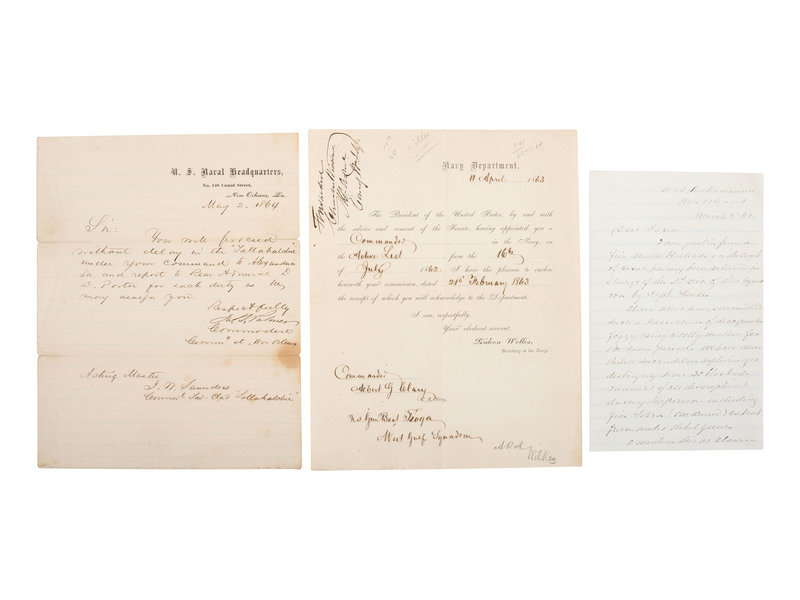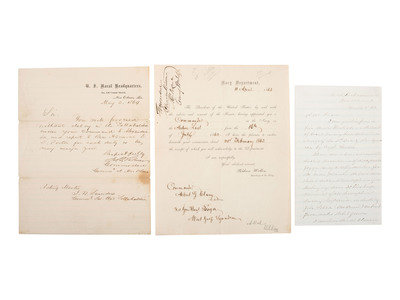Lot 805
[CIVIL WAR - NAVY]. A group of letters related to the West Gulf Blockading Squadron, comprising:
Sale 1096 - American Historical Ephemera & Photography
Lots Open
Nov 11, 2022
Lots Close
Nov 21, 2022
Timed Online / Cincinnati
Own a similar item?
Estimate
$200 -
400
Price Realized
$125
Sold prices are inclusive of Buyer’s Premium
Lot Description
[CIVIL WAR - NAVY]. A group of letters related to the West Gulf Blockading Squadron, comprising:
EMMONS, George F. (1811-1884). Autograph letter signed ("Geo. F. Emmons"), as commanding officer of the 2d Division of the West Blockading Squadron. Addressed to William Faxon (1822-1883), Chief Clerk, Navy Department. USS Lackawanna at New Orleans, 8 March 1865. 4 pp, 8vo. Emmons reports on his activities over the past five months as commanding officer of the 2d Division of the West Blockading Squadron: “We have nevertheless [i.e., despite awful weather] succeeded in capturing or disabling some 30 blockade runners of all descriptions during this period, including five schrs (one armed) cut out from under Rebel guns.” He continues that his main objective in writing is “to impress upon you what I think will be apparent to the Secretary and Mr. Fox—that the condition neither of this ship[,] the Ossipee[,] or the Monongahela is such as to warrant their usefulness longer on blockade without certain risks and delays as well as expensive outfits and repairs that must finally leave them very defective, without docking or such a thorough overhauling as cannot be accomplished without the aid of a dock, which they have not here.” He goes on to detail the problems and wonders of they can be addressed economically. “Light draft & fast vessel are what we most require now in this blockade.” Somewhat removed from the heat of battle, Emmons observes ruefully: “Our forces are concentrating at Mobile, and though they talk of the ‘last ditch’ &c I think it will turn out very much as at Savannah & Charleston—providing the tactics are similar.” Then he addresses his foremost concern: “While efforts are being made [indecipherable word(s)] by certain officers and their friends to promote certain persons who have been fortunate enough to have served in several battles & to have survived the same-- I am curious to know if those who have not been this favored but who have been as continuously and usefully employed during the Rebellion forfeit all claims to consideration in this respect. This enquiry does not concern me for I have been in several serious skirmishes, and upon one occasion was badly scarred.”
On April 24th, about a month after this letter was written, Emmons finally found himself back in battle. His ship and the Ossipee, Pembina, and Port Royal attacked the Confederate ram William H. Webb. Later that day, Emmons’s ships burned and destroyed the Webb. This was probably the last naval action of the Civil War. Emmons need not have worried about his career prospects. He was promoted to Commodore on 30 September 1868 and Rear Admiral on 25 November 1872.
[With:] Partly printed document with print signature of Gideon Welles as Secretary of the Navy. Navy Department, 11 April 1863. Informing Albert G. CLARY that he has been appointed Commander of the US Gunboat Tioga West Gulf Squadron. Under Clary’s command, the Tioga extended her record as an effective blockading vessel. On April 23, the British Justinian surrendered to her. At the end of June she captured the English Julia, and on September 25 she captured the Confederate steamer Herald.
[Also with:] PALMER, James S. (1810-1867). Letter signed ("Jas. S. Palmer"), on stationery of “U. S. Naval Headquarters, / No. 148 Canal Street, / New Orleans.” 2 May 1864. 1p, 7 3/4 x 9 3/4 in. Palmer orders Acting Master J. W. SAUNDERS, commanding the Iron-Clad Tallahatchie, to take her to Alexandria, LA, and report there to David D. PORTER. The Tallahatchie, a blockader in the Gulf of Mexico, was commissioned at New Orleans in March 1864 with Saunders in command. A career Navy man, in 1864, Palmer commanded the Naval Station at New Orleans and the West Gulf Squadron.
The Richard B. Cohen Civil War Collection
Condition Report
Contact Information

